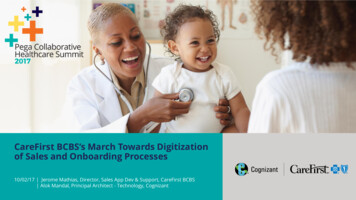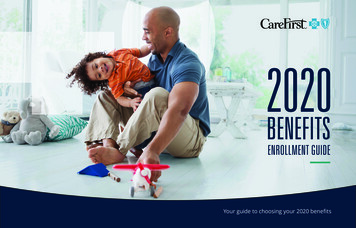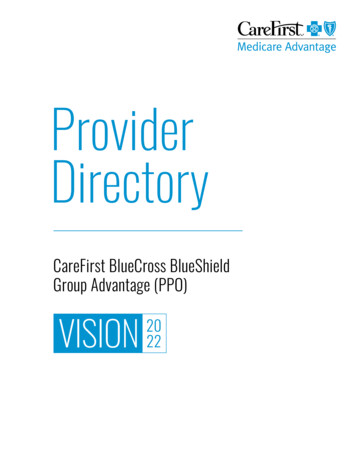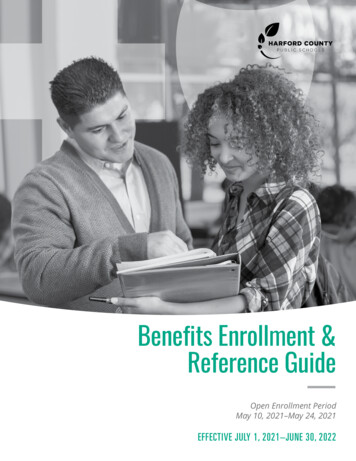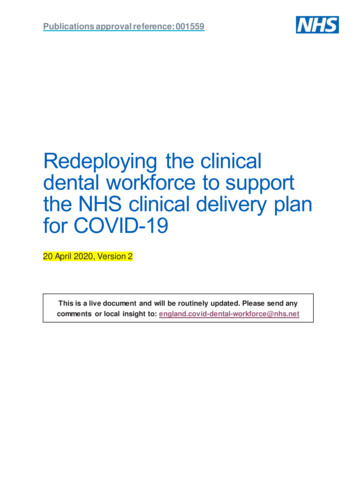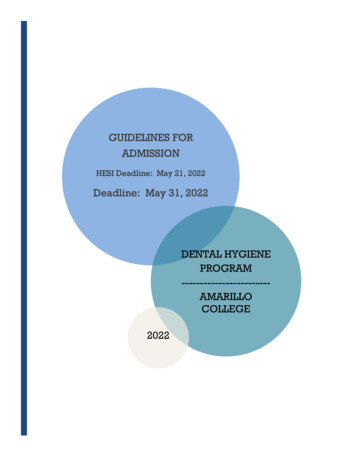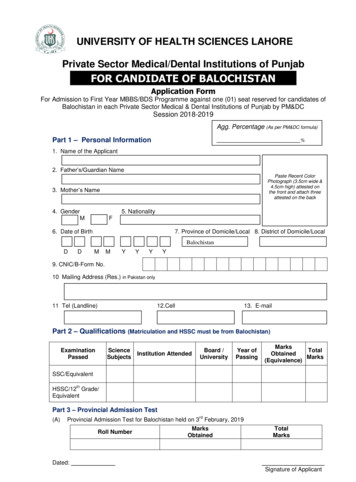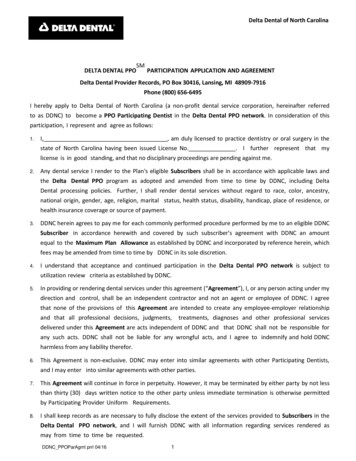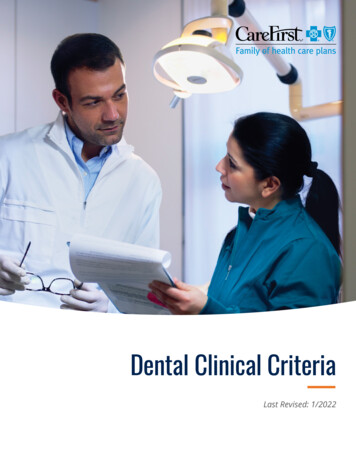
Transcription
Dental Clinical CriteriaLast Revised: 1/2022
ContentsIntroduction . . . . . . . . . . . . . . . . . . . . . . . . . . . . . . . . . 2Diagnostic . . . . . . . . . . . . . . . . . . . . . . . . . . . . . . . . . . 4Restorative . . . . . . . . . . . . . . . . . . . . . . . . . . . . . . . . . . 5Endodontics . . . . . . . . . . . . . . . . . . . . . . . . . . . . . . . . . 6Periodontics . . . . . . . . . . . . . . . . . . . . . . . . . . . . . . . . 7Prosthodontics (Removable) . . . . . . . . . . . . . . . . . . 10Implants and Related Services . . . . . . . . . . . . . . . . 11Fixed Prosthodontics . . . . . . . . . . . . . . . . . . . . . . . . 13Oral Surgery . . . . . . . . . . . . . . . . . . . . . . . . . . . . . . . 15Orthodontics . . . . . . . . . . . . . . . . . . . . . . . . . . . . . . . 17Adjunctive General Services . . . . . . . . . . . . . . . . . . 191 Dental Clinical Criteria
IntroductionThe clinical criteria are based upon procedurecodes in the Current Dental Terminology (CDT2022), American Dental Association .CareFirst’s Dental Clinical Criteria have beendeveloped, revised and updated periodically.They are reviewed and approved by the CareFirstDental Advisory Committee (DAC) and/or the Oraland Maxillofacial Surgery Advisory Committee(OMSFAC). The DAC is comprised of the DentalDirector who acts as chairperson for the committeeand 10 practicing network dentists. The OMSFACis comprised of the Dental Director, who acts aschairperson for the committee, and four practicingnetwork oral surgeons.The criteria are derived from reviews of the currentdental literature, subject textbooks, other industryinformation, and Practice Parameters, American Association ofPeriodontology (www.perio.org) Parameters of Care, American Association ofOral and Maxillofacial Surgery(www.aaoms.org) Oral Health Policies and Clinical Guidelines,American Academy of Pediatric Dentistry(www.aapd.org) Position Statements, American Association ofDental Consultants (www.aadc.org) Dental Practice Parameters, American DentalAssociation (www.ada.org)2 Dental Clinical CriteriaDental benefitsDental care benefits are provided as defined inthe members’ contracts. The members’ contractsmay exclude or impose frequency limits on certainprocedures and may vary based on regulatoryrequirements and/or the level of coveragepurchased by the employer group or individual.In-network dentists agree to CareFirst’s Schedule ofAllowances for covered services. Covered servicesare allowed a benefit only when dentally ormedically necessary as determined by CareFirst.Alternate benefitsMember contracts state “in the event there arealternative dental procedures that meet generallyaccepted standards of professional dental care fora Member’s condition, benefits will be based uponthe lowest cost alternative.” If a Member electsto have a more expensive procedure performed,it is the Member’s financial responsibility topay the difference to the provider between theallowed amount for the alternate benefit and thecontracted fee for the selected procedure.The professional review process All review of clinical information is performedby licensed dental professionals. Only a licensed dentist may deny a procedureas “not medically or dentally necessary”,“cosmetic in nature” or “experimentalor investigational”. Only a licensed dentist may consider aprocedure or claim on appeal. Administrative denials are based on membercontract provisions (i.e., benefit limitations,exclusions and annual contract periodmaximum) and do not require the review of alicensed professional.
I ntroductionRequired clinical informationProcedures requiring professional review alwaysrequire supporting clinical documentation.Please refer to the list of required documentationincluded as part of this document. As licenseddentists are reviewing your submitted information,please ensure that the images are of diagnosticquality to avoid a request for improved images.The information you send to CareFirst representsyour patient’s clinical situation and should berepresented in the most clear way possible.Sending your Clinical Information to CareFirstElectronic claims: CareFirst prefers and acceptselectronic dental claims from multiple third partyvendors (NEA, Tesia/RSS, DentalXChange (DXC))—use payer ID:00580.Paper claims: Mail your claims to the addressindicated on the back of the member’smembership card.Attachments and clinical documentation: Thesubmission of electronic attachments (radiographs,progress notes, charting, photos, etc.) is highlyrecommended and may be submitted to CareFirstthrough an electronic attachment vendor ofchoice. If you need to send attachments andclinical documentation as a hard copy with yourclaim, always be sure that your image is clearand diagnostic so as to expedite the clinicalreview process.3 Dental Clinical Criteria
DiagnosticRequests for services must meet the followingbasic criteria:Tests and examinationsCollection of microorganisms for cultureand sensitivityConsidered for benefit only in cases whenmoderate to severe infection requiresidentification of the infective organism toeffectively target antimicrobial therapy. Oral pathology laboratoryLaboratory accession of transepithelial cytologicsample, microscopic examination, preparation andtransmission of written report Pathological analysis of cytological sample ofdisaggregated transepithelial cells. Written report of findings.4 Dental Clinical Criteria
Restorativeor more of the natural tooth structureis missing.Requests for services must meet the followingbasic criteria:Inlay / Onlay Restorations Limited to permanent teeth. Any restorative procedure must be requiredas a result of extensive caries or trauma. A direct restoration is not feasible. Patient has a documented allergy to directrestorative materials.Onlays must completely cover at least onecusp of the posterior tooth and involvemultiple surfaces. Onlays must cover the complete incisaledge of an anterior tooth and more thanone surface. Buildups are not considered for inlays oronlays as dentally necessary due to theretention of multiple tooth surfaces. Minor restorations of carious areas,liners, bases or blocking out undercuts ina preparation do not qualify as a buildup(D2949). Closing of endodontic access cavity does notqualify as a build-up.Post and core Limited to permanent teeth. The tooth must be endodontically treated. The endodontically treated tooth must showadequate root canal fill without excessiveover- or under-fill. Free of endodontic signs/symptoms The tooth must present with a minimum of50 percent bone support. The patient must be free of activeperiodontal disease.The tooth must present with a minimum of50 percent bone support. The tooth must be sufficiently broken downwhere a more conservative base or buildupwould be contraindicated. The risk of root fracture or splitting the rootby placing a post is minimal. Crowns (Single Restorations) Limited to permanent teeth. Any restorative procedure must be requiredas a result of extensive caries or trauma. A direct or other more conservativerestoration is not feasible. Limited to permanent anterior teeth. Will not be covered if performed primarily forcosmetic reasons. The tooth must present with a minimum of50 percent bone support.Must be required as a result of cariesor trauma. The patient must be free of activeperiodontal disease.A direct or other more conservativerestoration is not feasible. The tooth must present with a minimum of50 percent bone support. The patient must be free of active periodontaldisease and gross caries. Must be free of endodontic signsor symptoms.An endodontically treated tooth must showadequate root canal fill without excessiveover fill and be asymptomatic. VeneersOther restorative servicesBuildup Limited to permanent teeth. The tooth must be sufficiently broken downthat a buildup is required for adequatesupport and retention of a crown, e.g., 50%5 Dental Clinical Criteria
EndodonticsRequests for services must meet the followingbasic criteria: Endodontic therapy on primary teethDocumented surgical defect must be largeenough to require graft for adequate healingwithout significant residual defect. Tooth must demonstrate advanced cariesor trauma.Biologic materials to aid in soft and osseous tissueregeneration in conjunction with periradicular surgery Root fracture must be absent. Clinical crown must be sufficient to retain arestoration, prefabricated resin or stainlesssteel crown.Biologic materials must result in significantimprovement in tissue regenerationand healing. Tooth must not be near exfoliation—rootresorption may not exceed 50 percent.May be considered inclusive (no additionalfee is paid by the member or CareFirst) byCareFirst when used in conjunction with bonegrafting and/or guided tissue regeneration(GTR).Endodontic therapy on permanent teeth (initialtreatment and re-treatment)Allowed services for teeth # 2–15, 18–31. Thirdmolars that are necessary to support theocclusion may be considered (#1, 16-17, 32). All canals must be instrumented, cleaned andsealed within 2mm of the radiographic apex. Tooth must present with documentedendodontic pathology and symptoms. Tooth must be restorable. Tooth must present with at least 50 percentbone support. Patient must be free of periodontal disease.Bone graft in conjunction with periradicular surgery6 Dental Clinical CriteriaGuided tissue regeneration, resorbable barrier, persite, in conjunction with periradicular surgery Use of the resorbable barrier for GTR mustresult in significant improvement in tissueregeneration and healing. This code is not to be used for resorbableor non-resorbable membranes, allogenicgrafting materials or other extra charges. thegrafting codes include the material unlessotherwise indicated.Canal preparation and fitting of preformed dowelor post This service is considered inclusive whensubmitted in conjunction with post/coreplacement by the same practitioner on thesame tooth. This service may be covered by anendodontist when performed as ancillary toendodontic therapy but not by the dentistwho is preparing the canal for the post andalso placing the post and fabricating the core.
PeriodonticsGingival flap procedure, including root planingGingival pockets must be moderately deep(5–8 mm) with loss of attachment. Tissue flapmust be necessary to access root calculus(modified Kirkland or Widman techniques). May be required to access or determine thepresence of a cracked tooth, fractured root orexternal root resorption. No additional benefit is allowed for the use ofa laser. Code may not be used in conjunction withgingivectomy or osseous surgery procedures. Do not use this code when placing implantson the same date of service. The appropriatecodes for that are D6103 and D6104. Do not use this code when performingperiradicular surgery on the same dateof service. The appropriate code for thatis D3428.Bone replacement graft—each additional sitein quadrant This procedure involves the use of autografts,allografts or non-osseous grafts to stimulateperiodontal regeneration when the diseaseprocess has resulted in bone deformity. Bone grafts are frequently performed inconjunction with osseous surgery but may bebilled as unique procedures. This code should be used for any siteadjacent to the primary bone graft site. May be considered inclusive when used inconjunction with bone grafting and/or GTR. Do not use this code when placing implantson the same date of service. The appropriatecodes for that are D6103 and D6104. Do not use this code when performingperiradicular surgery on the same dateof service. The appropriate code for thatis D3428.Osseous surgeryShould be preceded by scaling and rootplaning by at least four to six weeks to reducegingival and osseous inflammation priorto surgery. In cases where pockets are not expectedto be resolved with scaling and rootplaning (SRP) due to their depth (7 mm)and plaque control is adequate, it may bemore therapeutic to go directly to surgery.A detailed narrative should accompanythese requests. Post SRP evaluation should be afactor in determining the need forsurgical intervention. Includes reshaping the alveolar process toachieve a more physiologic form. Gingivectomies and/or flap surgeries maybe considered inclusive to osseous surgeryby CareFirst.Biologic materials to aid in soft and osseous tissueregeneration May be considered inclusive when used inconjunction with bone grafting and/or GTR. These materials may be used alone or withother regenerative materials such as boneand barrier membranes. This procedure does not include surgicalentry and closure, debridement, osseouscontouring or placement of graft materialsand membranes. This code is not to be used for resorbableor non-resorbable membranes, allogenicgrafting materials or other extra charges. Thegrafting codes include the material unlessotherwise indicated.Bone replacement graft—first site in quadrantThis procedure involves the use of autografts,allografts or non-osseous grafts to stimulateperiodontal regeneration when the diseaseprocess has resulted in bone deformity. Bone grafts are frequently performed inconjunction with osseous surgery but may bebilled as unique procedures. 7 Dental Clinical Criteria
PeriodonticsCareFirst will consider allowing a benefit forthis service when traditional regenerativeprocedures alone are unlikely to provideresolution of the tissue defect. A narrative detailing the necessity of thematerial is required in determining thisadditional regenerative benefit. Do not use this code in conjunction withperiradicular surgery.Guided tissue regeneration (GTR)—resorbable ornonresorbable barrier, per siteThis procedure may be used as appropriatefollowing surgical exposure and debridementto help close and protect the wound beforeapproximation of the mucoperiosteal flap. GTR is appropriate when the surrounding softand hard tissue is insufficient to retain thegraft material. A narrative detailing the necessity ofthe membrane material is requiredin determining this additionalregenerative benefit. Soft tissue allograft Must meet same criteria as other softtissue grafts. No donor site is required. Allograft material is inclusive. No additionalcharge for the graft material is allowed.Combined connective tissue and double pedicle graft Must meet same criteria as other softtissue grafts. Appropriate to correct advancedgingival recession.Free soft tissue graft procedure (including donorsite surgery), each additional contiguous tooth oredentulous tooth position in the same graft site A minimum amount of attached gingivaremains i.e., 2mm. Procedure is required for reasons otherthan cosmetics i.e., mucogingival defect,root sensitivity treated unsuccessfully bydesensitizing techniques or placementof restoration to increase the band ofkeratinized/attached gingiva, and/or tothicken the gingival housing at a prospectiveimplant site. Procedure includes both recipient bedpreparation and obtaining donor tissue,including use allograft material suchas Alloderm. Not to be reported in conjunction withfrenulectomy or frenuloplasty.Do not use this code in conjunction withperiradicular surgery. Connective tissue graft procedures (pedicle,subepithelial connective tissue and free soft tissuegraft procedures) A minimum amount of attached gingivaremains, i.e., 2mm. Procedure is required for reasons otherthan cosmetics, i.e., mucogingival defect,root sensitivity treated unsuccessfully bydesensitizing techniques or placementof restoration, to increase the band ofkeratinized/attached gingiva, and/or tothicken the gingival housing at a prospectiveimplant site.Procedure includes both recipient bedpreparation and obtaining donor tissue,including use of allograft material suchas Alloderm. 8 Dental Clinical CriteriaConsidered inclusive to frenulectomy orfrenuloplasty by CareFirstAutogenous connective tissue graft procedure(including donor and recipient surgical sites) Use D4273 for the first site in the quadrantand D4283 for each additional contiguous sitein that quadrant. Includes donor and graft site.
PeriodonticsNon-autogenous connective tissue graft (includingrecipient surgical site and donor material) Use D4275 for the first site in the quadrantand D4285 for each additional site inthat quadrant. Includes donor material and recipientsurgical site. This procedure is necessary when:Periodontal scaling and root planingOral exam and periodontal chartingindicate the patient presents with: Generalized moderate to severe gingivalinflammation involving ten (10) or moreteeth Moderate to heavy plaque and/orcalculus 2–4 mm pocketing. There maybe pseudopocketing. Gingival pockets 4mm. Radiographic evidence of active horizontaland/or vertical bone loss must be apparent. Bleeding points No vertical or horizontal bone loss There must be loss of attachment or apicalmigration of the attachment. No loss of attachment SRP of four (4) quadrants in sameappointment must be accompanied byrationale for doing four (4) quadrants inthe same visit, anesthesia used, length ofappointment and degree of provider (DDS,DMD, RDH).Gingival irrigation May be repeated every two (2) years, only ifmedically necessary. May be necessary as a pre-surgical ordefinitive therapy.Is a benefit under most dental plans whenpreceded by a definitive periodontalprocedure (D4240, D4260 and D4341) by nomore than two (2) years and no fewer than90 days. Contraindicated as a definitive therapy incases where the bone loss is so severe thatthere would be little to no therapeutic effect. Allowed up to twice per contract yearbeginning 4–6 weeks post definitiveperiodontal procedure. May be allowed upto four times per year for members withidentified chronic illnesses. Includes selective SRP, if required andpolishing teeth.Scaling in presence of generalized moderate orsevere gingival inflammation—full mouth, after oralevaluation Must be preceded by an oral evaluation(D0120, D0150, D0180). May be performed on the same day as anoral evaluation. Full mouth procedure. Patient must be 14 years or older.There are exceptions with adequateclinical documentation.9 Dental Clinical Criteria Not a covered benefit as there is insufficientscientific evidence regarding clinical efficacy.Periodontal maintenance
Prosthodontics (Removable)Requests for services must meet the followingbasic criteria: Replacement of any fixed or removableprosthesis is limited to five (5) years. There must be at least one (1) missing tooth(2–15, 18–31). Teeth 1, 16, 17 and 32 are not eligiblefor replacement.Overdentures—partial or complete Any retained teeth must present with at least50 percent bone support. Retained teeth must be permanent teeth atappropriate tooth positions for good retentionand stability. Implants and mini implants may be used toenhance retention and stability. Implants may be acceptable when there areno retained natural teeth and insufficientstability and retention to retain prosthodonticappliance is anticipated or exists.10 Dental Clinical Criteria
Implants and Related ServicesRequests for services must meet the followingbasic Clinical Criteria:1. Limited to the replacement of permanentteeth (2–15, 18–31 only).2. Replacements of teeth 1, 16, 17 and 32 arenot covered unless in functional occlusionand necessary to maintain occlusal support.3. Implant must have good crown-to-root ratio.osseous height or width, if a bony defectis present.11. Biologic mediators, Extracellular MatrixDerivative (EMD) may be consideredinclusive by CareFirst when used inconjunction with bone grafting and/or GTR.12. No benefit will be allowed in conjunctionwith a mini implant supported fixedprosthetic device (crown, bridge).4. Must be fully osseo-integrated.5. Must not have more than two (2) implantbody threads exposed above thealveolar crest.6. Implant must not be closer than 1.5 mm toadjacent roots or implants.7. The alveolar ridge implant placement sitemust present with good quality bone ofadequate mass and density.8. Active periodontal disease must be treatedand under control before implant placementto avoid possible complications. Whenthere is untreated generalized periodontaldisease throughout the remaining dentition,a more conservative treatment modalitymay be offered as an alternate benefit torestore the edentulous space and replace allmissing teeth, e.g., a fixed bridge or a full/partial denture.9. Implants may be contraindicated inyoung patients whose growth is expectedto continue.10. Immediate placement of an implant bodyinto an extraction site is an acceptableprocedure in many cases. These proceduresmay include placement of autogenousor allograft bone material in conjunctionwith GTR membrane, as needed to restore11 Dental Clinical CriteriaOther General Considerations:1. The use of synthetic bone graft material isnot recommended since these materialsappear to act as bone fillers, but do notgenerate the formation of new bone orperiodontal membrane.2. Implants may not be covered in some plans.3. If implants are not covered, then allservices associated with the implant serviceincluding but not limited to maintenanceand repairs, periodontal services forimplants and implant removal are excludedfrom coverage.4. In the case of surgical placement ofimplants, there is no alternative surgicaltreatment option; therefore, no alternatebenefit is available. An alternate benefitmay be applied to the prosthetic portionof the implant treatment plan (implantabutments and crowns, removable full orpartial dentures).
Implants and Related ServicesSecond stage implant surgery This codes describes the surgical access to animplant body for placement of a healing cap orto enable placement of an abutment.Most implants do not require a second stagesurgery. Will be permitted a benefit allowanceonly in limited situations when uncovering animplant is critically necessary. Rationale forneed should be submitted with the claim.Bone graft or repair of periimplant defect Necessary when there is an osseous or softtissue defect at an existing implant site. May be necessary when surgical interventionis required to access the defect. Does not include flap entry and closure. Does not include barrier membrane orbiologic materials.Do not use codes D4263, D4264 or D7953. Includes flap procedure and suturing. Not medically necessary for mini-implant.Bone graft at time of implant placementSurgical placement of mini implant Mini implants are indicated for retention of fulldentures that would otherwise be unstable. Not indicated to retain or support fixedpartial dentures. Not indicated to retain or support crowns. Includes the retrofitting of existing prosthesis. Does not require surgical flap and osteotomy. Does not require second stage surgery. Does not require surgical stent for placement.12 Dental Clinical Criteria Bone graft may be indicated to repair anosseous defect or improve significantlydebilitated architecture. Grafting may be indicated when implantis placed immediately into an extractionsocket, if there is a need to improve thebony architecture, as noted above. Narrativedescribing the clinical presentation and PA arerequired to support the need for the graft. Do not use D4263, D4264 or D7953 toreport bone grafting in conjunction withimplant placement.
Fixed ProsthodonticsRequests for services must meet the followingbasic criteria: Onlays must cover the complete incisal edgeof an anterior tooth and more than one (1)surface. The tooth must present with a minimum of50 percent bone support. The patient must be free of activeperiodontal disease. Non-functional teeth are not consideredfor benefits.Pontics Limited to the replacement of functionalpermanent teeth (#2-15, 18-31).Consideration will be given for functionalthird molar replacements if the support of theocclusion is incomplete without those teeth. Pontic space must be 75 percent the mesial–distal length of the missing tooth. The associated retainer teeth or implantsmust demonstrate a good five (5)year prognosis. If the retainer is denied, the pontic willbe denied. Two (2) pontic length, maximum allowed. Cantilevers should not involve more than one(1) pontic and the related abutment musthave at least 75 percent bone support.Retainers crowns Limited to the replacement of functionalpermanent teeth (#2-15, 18-31).Consideration will be given for functionalthird molar replacements if the support of theocclusion is incomplete without those teeth. Endodontics must be completed before teethare prepared and the bridge is placed. The tooth must present with a minimum of50 percent bone support. The patient must be free of activeperiodontal disease. Non-functional teeth are not consideredfor benefits.The patient must be free of activeperiodontal disease. If pontics are allowed an alternate benefit,the abutment crowns (retainers) will beconsidered for benefits independently basedupon their clinical status. Non-functional teeth are not consideredfor benefits. Provisional retainer crowns are notcovered and are considered inclusive to thefinal bridge. Abutment teeth should demonstratezero mobility.Retainers Inlays / Onlays Limited to permanent teeth. Inlays and onlays used as bridge retainersrequire a narrative that includes rationale fortheir use. 13Any restorative procedure must be requiredas a result of caries or trauma or may beallowed to support retention of a fixed bridge.Onlay must completely cover at least one(1) cusp of the posterior tooth and involvemultiple surfaces. Dental Clinical Criteria
F ixed ProsthodonticsPediatric partial denture, fixed A fixed prosthetic restoration replaces one(1) or more missing teeth in the primary,transitional or permanent dentition. This restoration attaches to natural teeth,tooth roots, or implants and it is notremovable by the patient. Growth must be considered when using fixedrestorations in the developing dentition.Recommendations: Fixed prosthetic restorations to replace one(1) or more missing teeth may be indicated to:14 establish esthetics; maintain arch space or integrity in thedeveloping dentition; prevent or correct harmful habits; or improve function. Dental Clinical Criteria
Oral SurgeryRequests for services must meet the followingbasic criteria:Other Surgical ProceduresOroantral fistula closure and Primary closure of asinus perforation Other Repair ProceduresOsseous, osteoperiosteal, or cartilage graft of themandible or maxilla Oral—antral communication must requiresurgical intervention for repair and healing.Procedure is considered necessary andappropriate when: Performed to repair a significant osseousdefect in the maxilla or mandible whichmay be caused by disease or injury,beyond that of a periodontal defect,commonly referred to as a block graft. The procedure includes ridgeaugmentation or reconstruction toincrease height, width and/or volume ofthe alveolar ridge. The procedure includes obtaining andplacing the graft material (autogenousgraft or allograft) and any related followup visit. Placement of a barrier membrane, if used,may be reported separately.Mobilization of erupted or malpositioned tooth to aideruption Tooth must be ankylosed. May not be associated with an extraction.Biopsy of oral tissue For pathological examination of abnormaltissue or lesion. Not to be used with apicoectomy /periradicular surgery. Copy of the pathology report and rationalefor biopsy should be included with theclaim submission.Brush biopsySinus augmentation with bone or bone substitutes The area must be edentulous. Must be done for implant site preparation. Brush biopsy is used as a screening techniqueand is usually not covered due to manyfalse positives. May be appropriate at time of implantplacement when implant stability cannot beobtained with existing bone. Sample collection of abnormally appearingmucosa or oral mucosal lesion. Short, wide implant body useis contraindicated. Biopsy may be required fordefinitive diagnosis. Placed in the absence of sinus pathology. Implant and implant services are coveredservices in the plan.Surgical excision of soft tissue lesions and intraosseous lesions and excision of bone tissue 15Tissue’s appearance must be documentedand appear abnormal or suspicious on theimage provided with the claim. Dental Clinical Criteria
Oral SurgeryBone replacement graft for ridge preservation Post extraction site presents withcompromised bone mass. At least one osseous plate is fenestratedor presents with dehiscence or is fracturedresulting in a major defect. Particular consideration for benefits will begiven to: Maxillary molar and premolar regions thatmay require grafting to provide adequatespace between the sinus and the implant. Maxillary and mandibular anteriorregions that may require bone grafts forcompromised (very thin osseous plate)facial bony walls. Mandibular molar regions whenthe nerve canal position is too closeto the edentulous ridge for properimplant placement.Frenulectomy and Frenuloplasty D7960, D7963 Procedure is considered necessary andappropriate when: The patients is an infant who is havingdifficulty latching for breastfeeding. Excessive lingual attachment is impedingspeech or swallowing. High labial attachment is preventingeruption of teeth. High labial attachment is creating adiastema or causing tooth rotation. Necessary to avoid or proceed withorthodontic treatment.Surgical reduction of fibrous tuberosity Soft tissue must be hypertrophied andinterfere with occlusion or the restorativespace for prosthetic restoration. Excessive tissue interferes with appropriatedenture flange extension.16 Dental Clinical Criteria
OrthodonticsCareFirst Dental ContractsCommercial Contracts
2 2 Dental Clinical Criteria Introduction The clinical criteria are based upon procedure codes in the Current Dental Terminology (CDT 2022), American Dental Association . CareFirst's Dental Clinical Criteria have been developed, revised and updated periodically . They are reviewed and approved by the CareFirst
